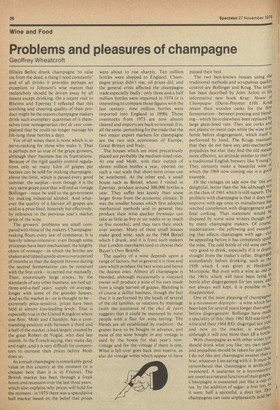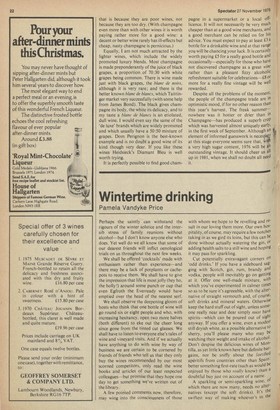Wine and Food
Problems and pleasures of champagne
Geoffrey Wheatcroft
Hilaire Belloc drank champagne 'to raise me from the dead, a thing I need constantly' and of all drinks it provides perhaps an exception to Johnson's wise maxim that melancholy should be driven away by all means except drinking. On a recent visit to Rheims and Epernay I reflected that this soothing and cheering quality of their pro
duct might be the reason champagne makers drink such exemplary quantities of it themselves (one nonagenarian chef de cave complained that he could no longer manage his life-long three bottles a day).
For of all wines there is none which is so nerve-racking for those who make it. That is perhaps not so true of the grape growers, although their business has its frustrations. Because of the rigid quality control regulations only so many kilos of grapes per hectare can be sold for making champagne: above the limit, which is passed every good summer, the surplus—even though it is the very same grape juice that will end as vintage Bollinger—must be sold to the government for making industrial alcohol. And whatever the quality of a harvest all grapes are sold at a price fixed, bizarrely but effectively, by reference to the previous year's market price of the wine.
The growers' problems are small compared with those of the makers. Champagnemaking flouts every law of commerce. It is heavily labour-intensive: even though some processes have been mechanised, the lengthy chore of remuage—in which the bottles are shaken and tipped upside-down over a period of months so that the deposit thrown during the second fermentation can be removed with the first cork—is carried out manually. Then, enormously large stocks, by the standards of any other business, are tied up: three-and-a-half years' supply on average, longer with some of the grander houses. And as the market is—or is thought to be--extremely price-sensitive, prices have been held at almost loss-leading levels. That is especially true in the United Kingdom where one firm. Moet and Chandon, has a commanding position with between a third and a half of the market, a lead largely created by the great Robert de Vogue, who died last month. In the Fr ench saying, they make day and night, and it is very difficult for competitors to increase their prices before Mot does so.
As a result champagne is remarkably good value in this country at the moment (it is cheaper here than it is in France). The British market has been through a freak boom and recession over the last three years, which also explains why prices will hold for the moment: in 1973 there was a speculative bull market based on the belief that prices were about to rise sharply. Ten million bottles were shipped to England. Cham pagne prices didn't rise, oil prices did, and the general crisis affected the champagne trade especially badly: only three and a half million bottles were imported in 1974 (it is interesting to compare those figures with the last century: nine million bottles were imported into England in 1890). Those overstocks from 1973 are now almost cleared and imports are back to normal. It is, all the same, perturbing for the trade that the two major export markets for champagne are the two sick economies of Europe, Great Britain and Italy.
The houses which are most precariously placed are probably the medium-sized ones. At one end Moet, with their output of eleven million bottles a year, operate on such a vast scale that short-term crises can be weathered. At the other end, a small house such as Boizel, whom I visited in Epernay, produce around 300,000 bottles a year. They suffer less keenly than some larger firms from the economic climate. It was the smaller houses which first adopted mechanical methods and in general they produce their wine quicker (remuage can take as little as five or six weeks or as much as five months); and they turn their stock over sooner. Many of these small houses make good wine, such as the 1964 Boizel which I drank, and it is from such makers that London merchants tend to choose their Buyer's Own Brands.
The quality of a wine depends upon a range of factors, but in general it is time and care which produce the best wines and hence the dearest ones. Almost all champagne is blended, although occasionally a vineyard owner will produce a wine of his own made from a single harvest of grapes. Blending is of course a skilful business, though the fact that it is performed by the heads of several of the old families, or relations by marriage (with the assistance of the chef de cave) suggests that it could be mastered by most people with a flair for wine tasting. The blends are all established by tradition : the grapes have to be bought in advance, and most of the wine bought in any vintage is used by the house for that year's nonvintage and for the vintage if there is one. What is left over goes back into reserve, as also do vintage wines which appear to have passed their best.
The two best-known houses using the traditional methods and scrupulous quality control are Bollinger and Krug. The latter has been described by John Arlott in his informative new book Krug: House of Champagne (Davis-Poynter £10). Krug retain their wooden casks for the first
fermentation between pressing and blend
ing—which have elsewhere been replaced bY large glass-lined vats. They use corks and not plastic-or metal caps while the wine is lb
bottle before disgorgement, which itself Is performed by hand. The Krugs maintatn that they do not have any anti-mechanical prejudices but That they find the old means, more effective, an attitude similar to that °I a traditional English brewery like young's;
They certainly make a beautiful wine of which the 1969 now coming out is a good example.
Of the vintages on sale now the '66s are delightful, better than the '64s although not
in the class of 1961 which is still superb. The problem with champagne is that it does 11°I improve with age once its manufacture has
reached completion with disgorgement and
final corking. That statement would be disputed by some wine writers though n°1 by many champagne makers. Of course, maderisation the yellowing and sweeter ing that affects champagne with age—eall be appealing before it has completely spoilt the wine. The odd bottle of old wine can be very good to drink, especially if it is drunk, straight from the maker's cellar, disgorge° immediately before drinking, such as the 1938 which I was given at Heidsieek Monopole. But even with a wine as old as the 1961s which will have been lying II; bottle after disgorgement for ten years, all° not always well kept, it is possible to be disappointed. One of the most pleasing of champagnes is a recemment degorgee—a wine which has, been kept for several years longer than usual before disgorgement. Bollinger have made a speciality of this; their 1961 RD was lovelY wine and their 1964 RD, disgorged last year and now on the market, is excellent, although it will cost more than £8 a bottle. With champagne as with other wines You should drink what you like: my own tastes and prejudices should be taken for just that. I do not like any champagne sweeter than `I brat, whatever I am eating with it. It must be remembered that champagne is artificiallY sweetened. A sauternes or a beerenauslese are sweet as a natural function of their graPest. Champagne is sweetened just like a cuP tea, by the addition of sugar: a brut has, as it were, half a spoonful, a c/oux ten. PrY. champagnes can taste unpleasantly acid bat
that is because they are poor wines, not because they are too dry. (With champagne even more than with other wines it is worth paying rather more for a good wine: a decent or better wine rarely has ill-effects but cheap, nasty champagne is pernicious.)
Equally, I am not much attracted by the lighter wines, which include the widely promoted luxury blends. Most champagne is made preponderantly of the juice of black grapes, a proportion of 70:30 with white grapes being common. There is wine made just with black grapes, the blanc de noirs, although it is very rare; and there is the better known blanc de Manes, which Taitt inger market very successfully (with some help from James Bond). The black gives champagne its body, the white its delicacy, and to my taste a Mane de /Vanes is an etiolated, dull wine. I would even say the same of the 'de luxe' brands which are widely promoted and which usually have a 50:50 mixture of grapes. Dom Perignon is the best-known example and is no doubt a good wine of its kind though very dear. If you like these wines Heidsieck's Diamant Bleu is well worth trying.
It is perfectly possible to find good cham pagne in a supermarket or a local offlicence. It will not necessarily be very much cheaper than at a good wine merchants, and a good merchant can be relied on for his advice. You must expect to pay at least £3 a bottle for a drinkable wine and at that range you will be chancing your luck. It is certainly worth paying £5 for a really good bottle and occasionally—especially for those who have not discovered champagne as a great wine rather than a pleasant fizzy alcoholic refreshment suitable for celebrations-0 or more for a really fine vintage will be well rewarded.
Despite all the problems of the moment, the people of the champagne trade are In optimistic mood, if for no other reason than this Year's harvest. The freak summer nowhere was it hotter or drier than in Champagne—has produced a superb croP which was harvested almost uniquely earlY. in the first week of September. Although an $1 element of informed guesswork is neces'' at this stage everyone seems sure that, W1 a very high sugar content, 1976 will be an outstanding vintage. It should cheer us all up in 1981, when we shall no doubt all need it.











































 Previous page
Previous page